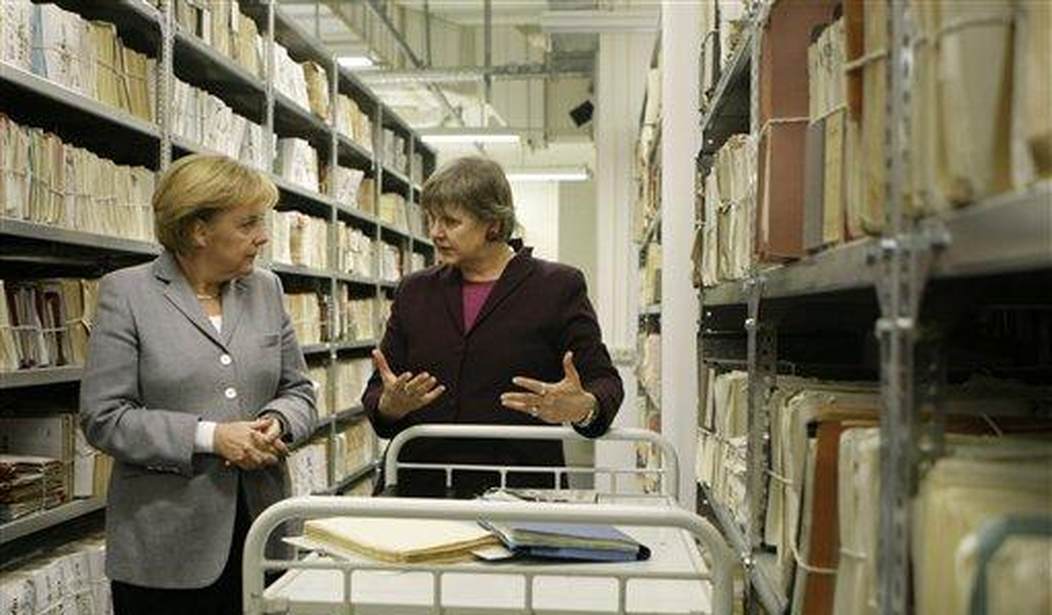German Chancellor Angela Merkel, left, and Marianne Birthler, Federal Commissioner for the Stasi Records, looks at documents during a visit of the Federal Department for the Stasi Records in Berlin, Germany, Thursday, Jan. 15, 2009. (AP Photo/Markus Schreiber, Pool)
Fade in. A title card reads “Temporary Detention Center; Ministry For State Security.” A policeman is holding a man by his arm in a darkened and scary looking corridor. He tells him, “Stand still. Eyes to the floor,” and then after a beat, “Walk on.” The prisoner is taken to a room, and the policeman tells him, “Address him as ‘Captain!’ Enter. Sit down. Hands under your thighs, palms down.” In front of the captain’s desk, the prisoner is seated on a small wooden chair, with a red cloth cushion.”
The captain asks him, “What do you have to tell us?”
The prisoner replies, “I’ve done nothing. I know nothing.”
The captain replies, “You’ve done nothing, know nothing…You think we imprison people on a whim? If you think our humanistic system capable of such a thing, that alone would justify your arrest.”
Just when the prisoner is ready to confess, the film cuts to a classroom, voyeuristically listening to a reel-to-reel tape of the same interrogation we’ve been watching. The tape is played to the class by a professor who is teaching future Stasi members how their profession works, telling them that it’s necessary to interrogate a prisoner for hours because “An innocent prisoner will become more angry by the hour, due to the injustice suffered. He will shout and rage. A guilty prisoner becomes more calm, more quiet, Or he cries. He knows he’s there for a reason. The best way to establish guilt or innocence is non-stop interrogation.”
If a student shouts out a sympathetic remark towards the taped prisoner, such as, “Why keep him awake for so long? It’s inhuman,” the professor subtly ticks a box with the student’s name on the classroom list. In other words, even the future spies are being spied upon.
The professor is no ordinary teacher. Eventually, we learn that he is Stasi Captain Gerd Wiesler, who during the two hours and 18 minutes of The Lives of Others, the brilliant 2006 film, the first effort by director Florian Henckel von Donnersmarck, then 33, is about to slowly undergo a surprising transformation.
Shortly after his class ends, Wiesler is tasked by the corpulent minister of East German culture, Bruno Hempf, to spy on a Brechtian playwright, Georg Dreyman, played by Sebastian Koch, who has become quite successful writing turgid melodramas that preach the party line. We eventually learn that Dreyman is targeted by Hempf not for slipping any subversive decadent capitalist messages into his plays, but because Hempf is having an affair with Dreyman’s beautiful girlfriend (played by Martina Gedeck), and Hempf wants to get the playwright permanently out of the way by tossing him into jail. Eventually Wiesler begins to become quite disgusted with his role in the destruction of a successful man, and rebels. Dreyman is also about to slowly undergo a transformation of his own.
East Germany: The Real-Life 1984
The Lives of Others is set, appropriately enough in the year 1984 – East Germany’s Stasi is Orwell’s omnipresent Thought Police made real:
The Nazi secret police, the Gestapo, could claim to have had around 40,000 operatives in a country of around 80 million people, while their Soviet equivalent, the KGB, had around 500,000 agents in a country with a population north of 280 million. The Stasi is estimated to have employed around 100,000 full-timers in a nation of just 17 million people…The upshot was that everyone, but everyone, knew that anyone could be a Stasi member and reporting back on their activities to their hierarchy. Throw in the informers and that number comes down to around one snoop per 66 East Germans, and that number, too, does not include the inoffizielle mitarbeiter (IM), the network of informers that the Stasi maintained on a temporary basis. With them, it is closer to one in six.
How ubiquitous were the Stasi in East Germany? It was reported that shortly before his death 2007 death, Ulrich Mühe, the East German-born actor who played Wiesler, discovered that his ex-wife was a Stasi informant.
Von Donnersmarck attempted to film in Hohenschönhausen, the actual main Berlin prison of the Stasi. However, he was unable to obtain permission from the director of the memorial site. As the Heritage Times notes, Dr. Hubertus Knabe “argued that von Donnersmarck wanted to make a Stasi man (Captain Gerd Wiesler, the film’s main protagonist) into a hero, to which von Donnersmarck used Schindler’s List to try and justify his plans for the film. To this Dr. Knabe allegedly replied: ‘But that is exactly the difference. There was a Schindler. There was no Wiesler.’”
For millions of East Germans, a nation formed by decree of the Soviet Union in 1949, it must have been cold comfort to see a National Socialist police state replaced with an International Socialist police state. The Stasi, East Germany’s Ministry for State Security, began the following year, East Germany’s equivalent, as a Soviet satellite state, of the KGB. Reportedly, some ex-Nazis served as Stasi spies. Even the uniforms of the Stasi looked similar to the Nazis, with the exception of a change of helmets.
In addition to the socialist collectivism, other attitudes enforced by the state remained identical; this was a topic explored in depth in von Donnersmarck’s 2018 film, Never Look Away, which begins with a young artist attending the National Socialists’ infamous “Degenerate Art” exhibition of 1937, with its attacks on all forms of art except for realism, only to be told 15 years later by his East German art professor that socialist realism is the only acceptable art form behind the Iron Curtain. In Never Look Away, Sebastian Koch, the playwright in Lives of Others, portrays an SS Medical Officer Karl Seeband who after the war, blends seamlessly into the East Germany’s Inner Party.
“In the person of Professor Seeband, the murderous eugenicist and the abortionist, the Nazi and the Communist, become one,” America Magazine noted in their review. “The doctor smoothly transitions from denying the rights of the individual in the name of the Volk to denying them in the name of class struggle.”
Dispatches from the Intersection of The Overlook Hotel and the Führerbunker
Like the actors from Stanley Kubrick’s prior movies who re-appear as ghosts in The Shining, watch enough German movies and TV series, and a lot of faces start to look familiar, often in rather ironic ways. Compared to Hollywood, the German acting pool is somewhat smaller, so it’s always fascinating to see an actor from 2004’s Downfall pop up in another film. Sometimes it’s done deliberately by the director and his casting agent, such as the 2009 Tom Cruise movie Valkyrie, where Cruise was supported by actors from both Downfall and the 2000 HBO movie about the Wannsee Conference, Conspiracy.
This was casting along the lines of Alfred Hitchcock’s movies, where the actors’ previous roles allows the director to waste little time establishing his characters. In German films, it’s occasionally done for the sake of satire, such as 2008’s The Baader Meinhof Complex, where the terrorists’ hatred of West Germany was played up by having the detectives chasing them portrayed by the actors who starred as Hitler and Albert Speer in Downfall.
In The Lives of Others, the man moving the chess pieces around is the aforementioned minister of culture, Bruno Hempf. Hempf is portrayed by Thomas Thieme (born in Weimar, appropriately enough), who played Martin Bormann in Downfall, and the presiding judge in The Baader Meinhof Complex. (Incidentally, to bring things full circle, according to the Grauniad, “Baader-Meinhof terrorist may have worked for the Stasi.” “Horst Mahler, a founding member of the Red Army Faction, was also a Stasi informant.”)
The scenes of Wiesler sitting in a darkened basement, headphones on, observing his stacks of video monitors and reel-to-reel recorders is highly reminiscent, intentional or not, of Francis Ford Coppola’s legendary 1974 film, The Conversation, where Gene Hackman played Harry Caul, an industrial spy-for-hire by major corporations and CEOs.
In The Conversation, Hackman slowly goes insane as he ponders who he is aiding: the CEO (Robert Duvall) who potentially wants to murder his wife (a pre-Laverne and Shirley Cindy Williams), or the CEO’s wife, who wants to murder the CEO. At the end of the film, told by his client’s assistant (played a pre-Star Wars Harrison Ford), “We’ll be listening to you,” Caul sits forlornly playing his saxophone after having demolished his apartment looking for the bug.
Released at the time of Watergate, as Wikipedia notes, “Coppola cited the 1966 film Blowup as a key influence. However, since the film was released to theaters just a few months before Richard Nixon resigned as President, he felt that audiences interpreted the film to be a reaction to the Watergate scandal.” However, Hackman’s character’s power was limited. He supplied recordings to whoever hired him, who in turn decided what to do with the surveillance tapes were turned in.
In sharp contrast, Wiesler’s power over Erich Honecker’s subjects was effectively unlimited. Observed breaking into Dreyman’s apartment by a middle-woman living in the apartment next door, Wiesler coldly threatens her: “Frau Meineke: One word of this to anyone, and Masha loses her spot at the university. Is that understood?”
Why Aren’t There More Movies About The Iron Curtain?
In contrast to the languid pacing of von Donnersmarck’s follow-up, Never Look Away, The Lives of Others has remarkable tension all the way through its 137 minute running time, perhaps because we’ve seen all the elements before in a variety of movies ranging from the James Bond series to Richard Burton’s The Spy Who Came In From The Cold: The shadowy concrete buildings and pools of light from streetlamps illuminating otherwise menacing-looking streets, the spies and their tradecraft, the surveillance state, the attempts to flee the Berlin Wall, etc. So why aren’t there more films about life behind the Iron Curtain? In 2007, when The Lives of Others played America’s art-house circuit, John Podhoretz theorized in the Weekly Standard:
I think there may be another reason for the reluctance of the makers of pop culture worldwide to reckon with communism, and that is shame. The ideological struggle against leftist totalitarianism was something that did not arouse the interest or enthusiasm of cultural elites in the West during the Cold War. Far from it; from the 1960s onward, the default position of the doyens of popular culture was a presumption in favor of the Communist struggle, as personified by Mao, the Viet Cong, Castro, the Sandinistas, El Salvador’s guerrillas, and the so-called African liberation movements.
This was not a reasoned, or thought-through, view. It was little more than fashion. And rarely, if ever, has history rendered a more devastating verdict on the wrongheadedness of fashionable Western groupthink than it did when the walls and statues came down, and Lenin was removed from his unholy pedestal.
They got it wrong. And though they may not know it, they are ashamed of it and do not wish to be reminded of it. Perhaps that’s why it took a 33-year-old to make this masterpiece–a 33-year-old who was too young during the Cold War to have joined any camp in any meaningful way. Florian Henckel von Donnersmarck found a great story to tell with a great setting and he told it with peerless skill while bearing none of the scars of past ideological battles.
In The Lives of Others, after the Wall fell, and Germany reunified, Hempf meets Dreyman in the lobby of a Berlin theater while one Dreyman’s plays is being shown. Hempf tells him, “You’ve not written since the Wall fell? That’s not good, after all our country invested in you. Although I understand you, Dreyman. What is there to write about in this new Germany? Nothing to believe in, nothing to rebel against. Life was good in our little Republic. Many people only realize that now.”
Martin Bormann couldn’t have said it better about the socialist empire he served.
In his Weekly Standard review, John Podhoretz wrote that as directorial debuts go, The Lives of Others is on-par with Orson Welles’ Citizen Kane, and while they’re obviously very different films in terms of content and style – he’s not wrong. No less than William F. Buckley, a year before his death at age 82, wrote in 2007 that von Donnersmarck’s film is “the best movie I ever saw…The tension mounts to heart-stopping pitch and I felt the impulse to rush out into the street and drag passersby in to watch the story unfold.”
Freedom Versus Security
The Lives of Others is a remarkably timely movie right now, for multiple reasons. We’ve seen several blue enclaves in America, such as Los Angeles, Manhattan, and Houston attempt to setup snitch lines to turn in businesses reopening ahead of the Coronavirus lockdown schedule. Similarly, as I was completing this article, the Orwellian headline, “Antifa protests against ending the lockdown in Germany,” made the rounds on Twitter.
The details of Obama’s spying on the incoming Trump administration (aka “Obamagate”) are beginning to trickle out, likely accelerating in quantity as November approaches, an extension of Obama’s spying on reporters. And perhaps even more ominously, Vijeta Uniyal of the Legal Insurrection blog recently spotted an alarming headline in “Der Spiegel magazine: ‘Young Germans are turning into China fans.’ Nearly half of them want closer ties with China over the U.S.”
Politics runs alongside two poles: freedom and security. For most of America’s history, the former was its government’s goal. Under FDR’s New Deal in the 1930s, “This shift from a government aimed at protecting Freedom to one designed to provide Security is the single most important thing that happened in 20th Century America,” conservative blogger and book reviewer Orrin Judd wrote in 2000. And more security means more laws – and the potential for more to be arrested.
Earlier this month, a Reason magazine article was headlined, “The New York Times Recoils at the Predictable Consequences of the Mandatory COVID-19 Precautions It Supports.” As Glenn Reynolds noted when linking to it at Instapundit, “Government Is Force. If You Don’t Like Violence, Don’t Call For Laws.” Today’s Germans are determined to seek security in socialism, not realizing they could be about to make the same mistakes as their 20th century predecessors.










Join the conversation as a VIP Member